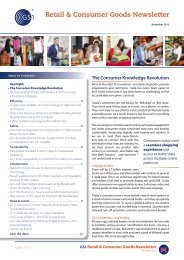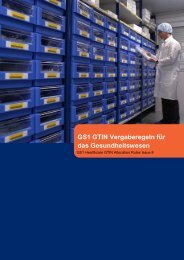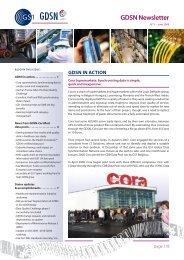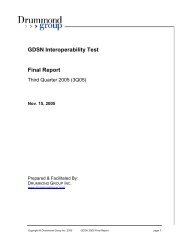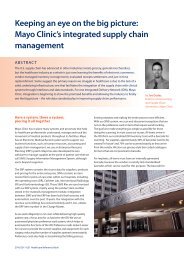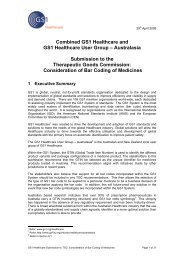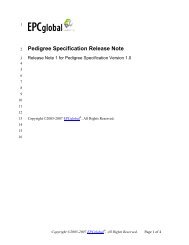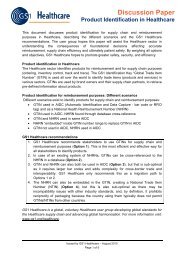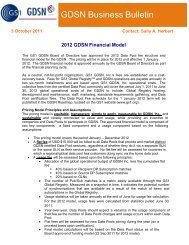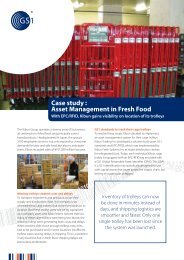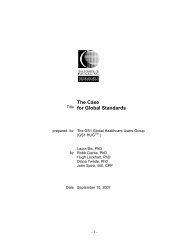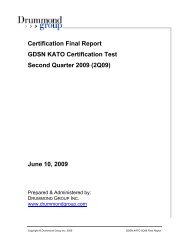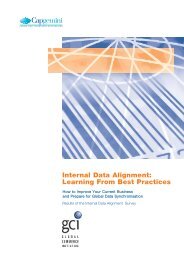The Application Level Events (ALE) Specification, Version 1.0 - GS1
The Application Level Events (ALE) Specification, Version 1.0 - GS1
The Application Level Events (ALE) Specification, Version 1.0 - GS1
Create successful ePaper yourself
Turn your PDF publications into a flip-book with our unique Google optimized e-Paper software.
465<br />
466<br />
467<br />
468<br />
469<br />
470<br />
471<br />
472<br />
473<br />
474<br />
475<br />
476<br />
477<br />
478<br />
479<br />
480<br />
481<br />
482<br />
483<br />
484<br />
485<br />
486<br />
487<br />
488<br />
489<br />
490<br />
491<br />
492<br />
493<br />
494<br />
• If the number of reader devices must change – e.g., because it is discovered that four<br />
reader devices are required instead of three to obtain adequate coverage of a<br />
particular loading dock door – then the application must be changed.<br />
To avoid these problems, <strong>ALE</strong> introduces the notion of a “logical reader.” Logical<br />
readers are abstract names that a client uses to refer to one or more Readers that have a<br />
single logical purpose; e.g., DockDoor42. Within the implementation of <strong>ALE</strong>, an<br />
association is maintained between logical names such as DockDoor42 and the physical<br />
reader devices assigned to fulfill that purpose. Any <strong>ALE</strong> event cycle specification that<br />
refers to DockDoor42 is understood by the <strong>ALE</strong> implementation to refer to the physical<br />
reader (or readers) associated with that name.<br />
Logical names may also be used to refer to sources of raw EPC events that are<br />
synthesized from various sources. For example, one vendor may have a technology for<br />
discriminating the physical location of tags by triangulating the results from several<br />
reader devices. This could be exposed in <strong>ALE</strong> by assigning a synthetic logical reader<br />
name for each discernable location.<br />
Different <strong>ALE</strong> implementations may provide different ways of mapping logical names to<br />
physical reader devices, synthetic readers, and other sources of EPC events. This is a key<br />
extensibility point. At a minimum, however, all <strong>ALE</strong> implementations SHOULD provide<br />
a straightforward way to map a logical name to a list of read event sources, and where<br />
physical readers allow for independent control over multiple antennas and multiple tag<br />
protocols, each combination of (reader, antenna, protocol) should be treated as a separate<br />
read event source for this purpose. To illustrate, an <strong>ALE</strong> implementation may maintain a<br />
table like this:<br />
Logical Reader<br />
Name<br />
DockDoor42<br />
DockDoor43<br />
Physical Reader Devices<br />
Reader Name Antenna Protocol<br />
Acme42926 0 UHF<br />
Acme42926 1 UHF<br />
Acme43629 0 UHF<br />
Acme44926 0 UHF<br />
Acme44926 1 UHF<br />
Acme49256 0 UHF<br />
(It must be emphasized that the table above is meant to be illustrative of the kind of<br />
configuration data an <strong>ALE</strong> implementation might maintain, not a normative specification<br />
of what configuration data an <strong>ALE</strong> implementation must maintain.)<br />
More elaborate implementations of <strong>ALE</strong>, such as those that provide synthesized logical<br />
readers such as the triangulation example above, will require more elaborate<br />
configuration data. Tables of this kind may be established through static configuration,<br />
Copyright © 2005, 2004 EPCglobal Inc, All Rights Reserved. Page 15 of 71



